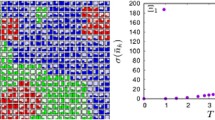Abstract
In 2014, P.S. Krasnoshchekov, Academician at the Russian Academy of Sciences, offered A.A. Belolipetskii to continue research on the collective behavior of people by generalizing his earlier static model to the dynamic case. For this reason, this work is regarded as a tribute to commemorate Krasnoschekov, an outstanding scientist. The fundamental quantitative model Krasnoshchekov proposed in his works studied a static model of collective behavior when people can change their original opinion on a subject after one stage of informational interaction. Opinions are assumed to be alternatives. A person can support his country to join the WTO with probability p and object to it with probability 1 - p. In this work, multistep opinion exchange processes are considered. Quantitative characteristics of values of probabilities p (of people’s opinions) are obtained as functions of the step number and the rate of change of these probabilities. For instance, the way the mass media can control the opinions of their target audience if this audience has certain psychological characteristics is studied.
Similar content being viewed by others
References
P. S. Krasnoshchekov, “The simplest mathematical model of behaviour. Psychology of conformism,” Mat. Model. 10 (7), 76–92 (1998).
P. S. Krasnoshchekov and A. A. Petrov, Principles of Model Construction (Fazis, VTs RAN, Moscow, 2000) [in Russian].
A. A. Vasin, P. S. Krasnoshchekov, and V. V. Morozov, Study of Operations. Applied Mathematics and Informatics (Akademiya, Moscow, 2008) [in Russian].
T. C. Schelling, The Strategy of Conflict (Harvard Univ. Press, Boston, 1980).
A. Banerjee and T. Besley, “Peer group externalities and learning incentives: a theory of nerd behavior,” J. M. Olin Discussion Paper No. 68 (Dep. Economics, Woodrow Wilson School of Public Int. Affairs, Princeton Univ. Press, Princeton, 1990).
D. Helbing, I. Farkas, P. Molnar, and T. Vicsek, “Simulation of pedestrian crowds in normal and evacuation situations,” Pedestr. Evacuat. Dyn. 21 (2), 21–58 (2002).
M. E. Stepantsov, “Mathematical model for the directed motion of a people group,” Mat. Model. 16 (3), 43–49 (2004).
E. S. Kirik, D. V. Kruglov, and T. B. Yurgel’yan, “On discrete people movement model with environment analysis,” Zh. Sib. Fed. Univ., Ser. Mat. Fiz. 1 (3), 262–271 (2008).
V. V. Breer, “Conformal behavior models. Part 1. From philosophy to math models,” Probl. Upravl. 11 (1), 2–13 (2014).
P. P. Makagonov, S. B. R. Espinosa, and K. A. Lutsenko, “Algorithm for expert influence calculation on information consumer in social networks and educational sites,” Model. Analiz Dannykh, No. 1, 74–85 (2014).
A. A. Belolipetskii and I. V. Kozitsin, “On one mathematical model of collective behavior in differential form,” in Mathematical Simulation of Information Systems (Mosk. Fiz. Tekh. Inst., Moscow, 2015), pp. 66–73 [in Russian].
A. L. Beklaryan, “Exit front in the model of crowd’s behavior in extreme situations,” Vestn. Tambov. Univ., Ser.: Estestv. Tekh. Nauki 20 (5), 11–23 (2015).
F. R. Gantmakher, Matrix Theory (Nauka, Fizmatlit, Moscow, 1967; Chelsea, New York, 1960).
S. A. Ashmanov, Introduction to Mathematical Economics (Moscow, Nauka, 1984) [in Russian].
Author information
Authors and Affiliations
Corresponding author
Additional information
Original Russian Text © A.A. Belolipetskii, I.V. Kozitsin, 2017, published in Izvestiya Akademii Nauk, Teoriya i Sistemy Upravleniya, 2017, No. 3, pp. 47–58.
Rights and permissions
About this article
Cite this article
Belolipetskii, A.A., Kozitsin, I.V. Dynamic variant of mathematical model of collective behavior. J. Comput. Syst. Sci. Int. 56, 385–396 (2017). https://doi.org/10.1134/S1064230717030054
Received:
Revised:
Published:
Issue Date:
DOI: https://doi.org/10.1134/S1064230717030054




